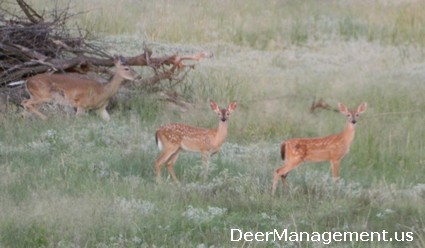The key to maintaining a healthy white-tailed deer population is to have good deer habitat. Habitat is the cornerstone to managing a native deer herd year-in and year-out and into the future. Without suitable deer habitat, all will be lost—including hunting. It takes high quality plants for deer to forage on. It takes habitat to serve as refuge from extreme temperatures. It also takes good habitat for fawn protection and production.
It is generally believed that tall grass provides some of the best fawn protection around. Grass is not all that valuable to deer from a food perspective because they eat very little of it, it is in low amounts in their diet. However, grass can help big time when it comes to travel cover and especially for fawn screening cover. Or does it? Research out of Texas looked at just that: “Is tall grass beneficial to fawns?”

Source: “There was no difference between the bedsite characteristics selected by fawns at seven and fourteen days. In the first study year (2011), grass cover was lower for fawn sites versus random sites. The reverse was true in 2012, with fawn bedsites having greater grass cover. Fawns chose sites nearer to a shrub than random places, particularly in east and west directions. Since these directions were most likely to provide shade from the sun, this was a clue that fawns were trying to stay cool. Bedsites generally contained more concealing cover (viewed horizontally from coyote height) by all types of vegetation (grass, shrubs, forbs, cacti, etc.) than random sites. And, bedsites were cooler, 92 degrees F versus random sites at 96 degrees F.
So, what is the take-home message from these results? First, thick, tall grass can be important,but only when combined with other characteristics such as clumps of shrubs. Although we did not specifically measure proximity to openings, fawns appeared to select for concealment at the edge of small openings. Thus, managers should strive to provide a diverse habitat with small openings intermixed with cover that provides horizontal concealment along with shade. If a manager feels the need to plant grass for fawn cover, we recommend native grasses that are now commercially available from seed companies.”
Though the research did not find nail down any specific aspects of fawn bedding sites, it is important to note that the data did not mention the deer density of the area where the research took place. This could be an important component of the study, since the home ranges of does tend to decrease as numbers increase. This could limit potential bedding sites to whatever habitat is available in their area.
It’s also interesting that there was no mention of fawn mortality. Is there a low predator population in the area? Are the does there placing fawns indiscriminately allow fawns to bed up anywhere because the area is “safe.” It is important to note that good grass cover in general may deter predators from using the area as much. I definitely don’t think it will hurt anyone’s deer management program. In short, aim for a diverse habitat that provides a variety of plants and whitetail deer will find what they need.